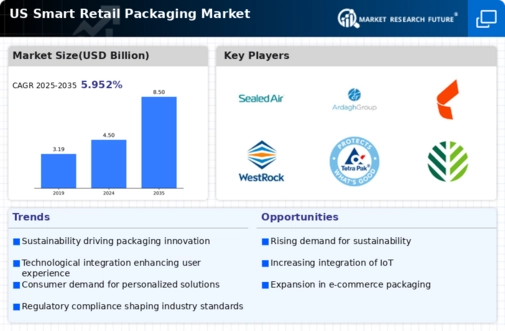Integration of IoT and Data Analytics
The integration of Internet of Things (IoT) technology and data analytics is significantly influencing the smart retail-packaging market. By embedding sensors and connectivity features into packaging, companies can gather real-time data on product conditions and consumer interactions. This capability allows for improved inventory management and enhanced customer engagement. Recent studies indicate that the use of IoT in packaging can reduce waste by up to 30%, thereby appealing to environmentally conscious consumers. As businesses recognize the potential of data-driven insights, the smart retail-packaging market is poised for substantial growth, driven by the demand for smarter, more connected packaging solutions.
Consumer Demand for Enhanced Convenience
The smart retail-packaging market is experiencing a notable shift driven by consumer demand for enhanced convenience. As lifestyles become increasingly fast-paced, consumers are seeking packaging solutions that simplify their shopping experience. This trend is reflected in the growing preference for smart packaging that offers features such as easy-open designs, resealability, and portion control. According to recent data, approximately 65% of consumers in the US express a preference for packaging that enhances usability. This demand for convenience is prompting manufacturers to innovate and invest in smart packaging technologies, thereby propelling growth in the smart retail-packaging market.
E-commerce Growth and Packaging Adaptation
The rapid growth of e-commerce is reshaping the smart retail-packaging market. As online shopping continues to gain traction, there is an increasing need for packaging that can withstand the rigors of shipping while ensuring product integrity. Smart packaging solutions that offer durability and protection during transit are becoming essential. According to market analysis, e-commerce sales in the US are projected to reach $1 trillion by 2025, necessitating innovative packaging solutions that cater to this expanding market. Consequently, manufacturers are focusing on developing smart packaging that not only meets the demands of e-commerce but also enhances the unboxing experience for consumers.
Regulatory Compliance and Safety Standards
Regulatory compliance and safety standards are pivotal drivers in the smart retail-packaging market. The US government has implemented stringent regulations regarding food safety and product labeling, necessitating the adoption of smart packaging solutions that ensure compliance. For instance, the Food and Drug Administration (FDA) mandates clear labeling and traceability for food products, which can be effectively achieved through smart packaging technologies. This regulatory landscape compels manufacturers to invest in smart packaging that not only meets safety standards but also enhances transparency. As a result, the smart retail-packaging market is likely to witness increased adoption of technologies that facilitate compliance and improve consumer trust.
Sustainability and Eco-Friendly Innovations
Sustainability is a driving force in the smart retail-packaging market, as consumers and businesses alike prioritize eco-friendly solutions. The increasing awareness of environmental issues has led to a demand for packaging that minimizes waste and utilizes recyclable materials. Companies are investing in smart packaging technologies that incorporate biodegradable materials and reduce carbon footprints. Recent surveys indicate that over 70% of consumers in the US are willing to pay more for sustainable packaging options. This shift towards sustainability is prompting innovation within the smart retail-packaging market, as manufacturers strive to meet consumer expectations while adhering to environmental regulations.



















Leave a Comment